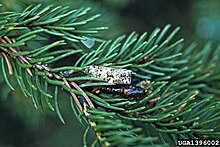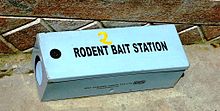Pest control
[3] In homes and urban environments, the pests are the rodents, birds, insects and other organisms that share the habitat with humans, and that feed on or spoil possessions.[7] The conventional approach was probably the first to be employed, since it is comparatively easy to destroy weeds by burning them or ploughing them under, and to kill larger competing herbivores.[10] The harmful side effect of pesticides on humans has now resulted in the development of newer approaches, such as the use of biological control to eliminate the ability of pests to reproduce or to modify their behavior to make them less troublesome.[12] It relies on predation, parasitism, herbivory, parasitody or other natural mechanisms, but typically also involves an active human management role.[14] Mechanical pest control is the use of hands-on techniques as well as simple equipment and devices, that provides a protective barrier between plants and insects.This is particularly important in countries where there are natural reservoirs of pests and their enemies in the countryside surrounding plantation crops, and these co-exist in a delicate balance.Where progressive farmers are using fertilizers to grow improved crop varieties, these are often more susceptible to pest damage, but the indiscriminate application of pesticides may be detrimental in the longer term.[20] Pesticides are intended to kill pests, but many have detrimental effects on non-target species; of particular concern is the damage done to honey-bees, solitary bees and other pollinating insects and in this regard, the time of day when the spray is applied can be important.[33] In some regions, such as New Brunswick, areas of forest are sprayed with pesticide to control the budworm population and prevent the damage caused during outbreaks.Garden Guns are short-range weapons that can do little harm past 15 to 20 yards, and they're relatively quiet when fired with snake shot, compared to standard ammunition.These guns are especially effective inside of barns and sheds, as the snake shot will not shoot holes in the roof or walls, or more importantly, injure livestock with a ricochet.Special smoothbore shotguns, such as the Marlin Model 25MG can produce effective patterns out to 15 or 20 yards using .22 WMR shotshells, which hold 1/8 oz.Poisoned bait is a common method for controlling rats, mice, birds, slugs, snails, ants, cockroaches, and other pests.[43] Fumigation is the treatment of a structure to kill pests such as wood-boring beetles by sealing it or surrounding it with an airtight cover such as a tent, and fogging with liquid insecticide for an extended period, typically of 24–72 hours.[46] To chemically sterilize pests using chemosterilants, laboratory studies conducted using U-5897 (3-chloro-1,2-propanediol) attempted in the early 1970s for rat control, although these proved unsuccessful.[49] Boron, a known pesticide can be impregnated into the paper fibers of cellulose insulation at certain levels to achieve a mechanical kill factor for self-grooming insects such as ants, cockroaches, termites, and more.[51]: 133 Several wildlife rehabilitation organizations encourage natural form of rodent control through exclusion and predator support and preventing secondary poisoning altogether."[53] The United States Environmental Protection Agency has prescribed guidelines for natural rodent control[54] and for safe trapping in residential areas with subsequent release to the wild.[60] Since pesticides are not safe to use near food, alternative treatments such as freezing for four days at 0 °F (−18 °C) or baking for half an hour at 130 °F (54 °C) should kill any insects present.[61] The larvae of clothes moths (mainly Tineola bisselliella and Tinea pellionella) feed on fabrics and carpets, particularly those that are stored or soiled.The adult females lay batches of eggs on natural fibres, including wool, silk, and fur, as well as cotton and linen in blends.Damage is often concentrated in concealed locations, under collars and near seams of clothing, in folds and crevices in upholstery and round the edges of carpets as well as under furniture.They tend to infest hidden locations and may feed on larger areas of fabrics than do clothes moths, leaving behind specks of excrement and brown, hollow, bristly-looking cast skins.Prevention of attack relies on keeping books in cool, clean, dry positions with low humidity, and occasional inspections should be made.[67] Termites with colonies in close proximity to houses can extend their galleries underground and make mud tubes to enter homes.The insects keep out of sight and chew their way through structural and decorative timbers, leaving the surface layers intact, as well as through cardboard, plastic and insulation materials.Soil-applied liquid termiticides provide a chemical barrier that prevents termites from entering buildings, and lethal baits can be used; these are eaten by foraging insects, and carried back to the nest and shared with other members of the colony, which goes into slow decline.

















Pest Control (Doctor Who)Pest Control (band)Pest Control (album)agricultural aircraftwestern corn rootwormspeciesintegrated pest managementmechanicalculturalchemicalbiologicalpesticidesvarietiespredatorsparasitesrodentsinsectsquarantineagricultureFerretsMongoosesancient Egyptianscrop rotationcompanion plantingselective breedingcultivarsRed weaver antsSumerianssulphurinsecticidesColorado potato beetlearsenicalindustrialisationmechanizationpyrethrumderrisherbicidesbiological controlOecophylla smaragdinacitrusladybirdsscale insectsBiological pest controlparasitoid waspCotesia congregataManduca sextausing other organismspredationparasitismherbivoryparasitodyBacillus thuringiensisploughingblack-headed gullsSpruce budwormpheromone trapsMechanical pest controlInsect trapprotective barrierplantstillagecommon click beetlehost plantscorn rootwormTrap cropPesticideinsecticideIps sexdentatusfungicidesseed dressingsresistant straindamagehoney-beespollinating insectsneonicotinoidscancerMaximum residue limitsPlant defense against herbivoryPlant disease resistanceinheritablegenetic engineeringBt cornpassenger pigeonsOverhuntingVarmint huntingcullingecological nichespastureshuman settlementshunterstrappersverminvectorstransmitpathogensacross speciesto humanspopulation controlprotectingvulnerable speciesecosystemsselective pressurebehaviouraldemographicadaptingfaster reproductive cyclesForestrysprucebalsam firrepellentsPhysical pest controlRekong PeoHimachal Pradeshrat-catcherspheromonesspring trapsGarden Guns.22 calibersnake shotlivestockricochetairportswarehousesstockyardsMarlin Model 25MGChennai